check engine light TOYOTA C-HR 2020 (in English) User Guide
[x] Cancel search | Manufacturer: TOYOTA, Model Year: 2020, Model line: C-HR, Model: TOYOTA C-HR 2020Pages: 536, PDF Size: 11.99 MB
Page 193 of 536
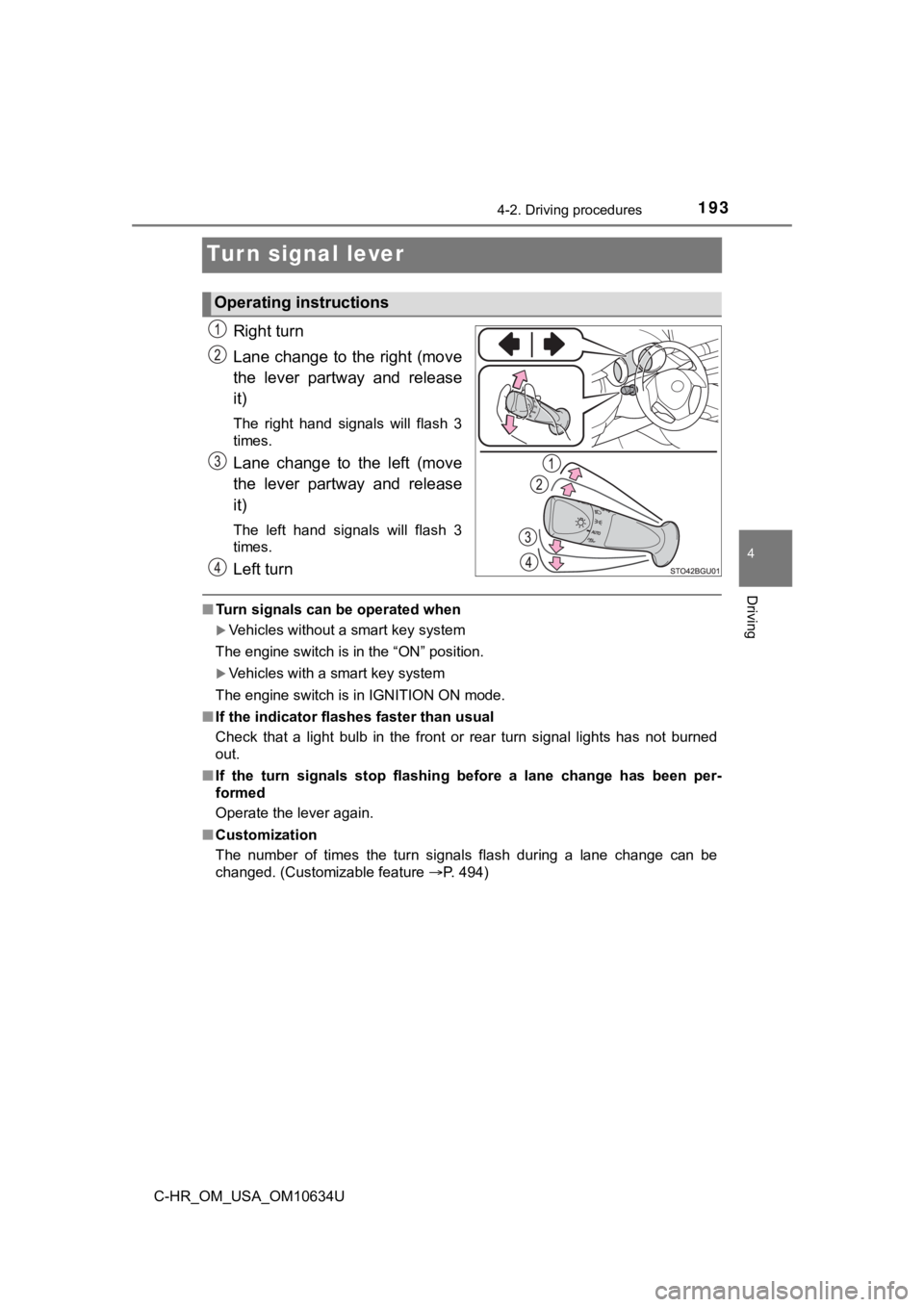
1934-2. Driving procedures
4
Driving
C-HR_OM_USA_OM10634U
Turn signal lever
Right turn
Lane change to the right (move
the lever partway and release
it)
The right hand signals will flash 3
times.
Lane change to the left (move
the lever partway and release
it)
The left hand signals will flash 3
times.
Left turn
■Turn signals can be operated when
Vehicles without a smart key system
The engine switch is in the “ON” position.
Vehicles with a smart key system
The engine switch is in IGNITION ON mode.
■ If the indicator flashes faster than usual
Check that a light bulb in the front or rear turn signal lights has not burned
out.
■ If the turn signals stop flashing before a lane change has been per-
formed
Operate the lever again.
■ Customization
The number of times the turn signals flash during a lane change can be
changed. (Customizable feature P. 494)
Operating instructions
Page 214 of 536
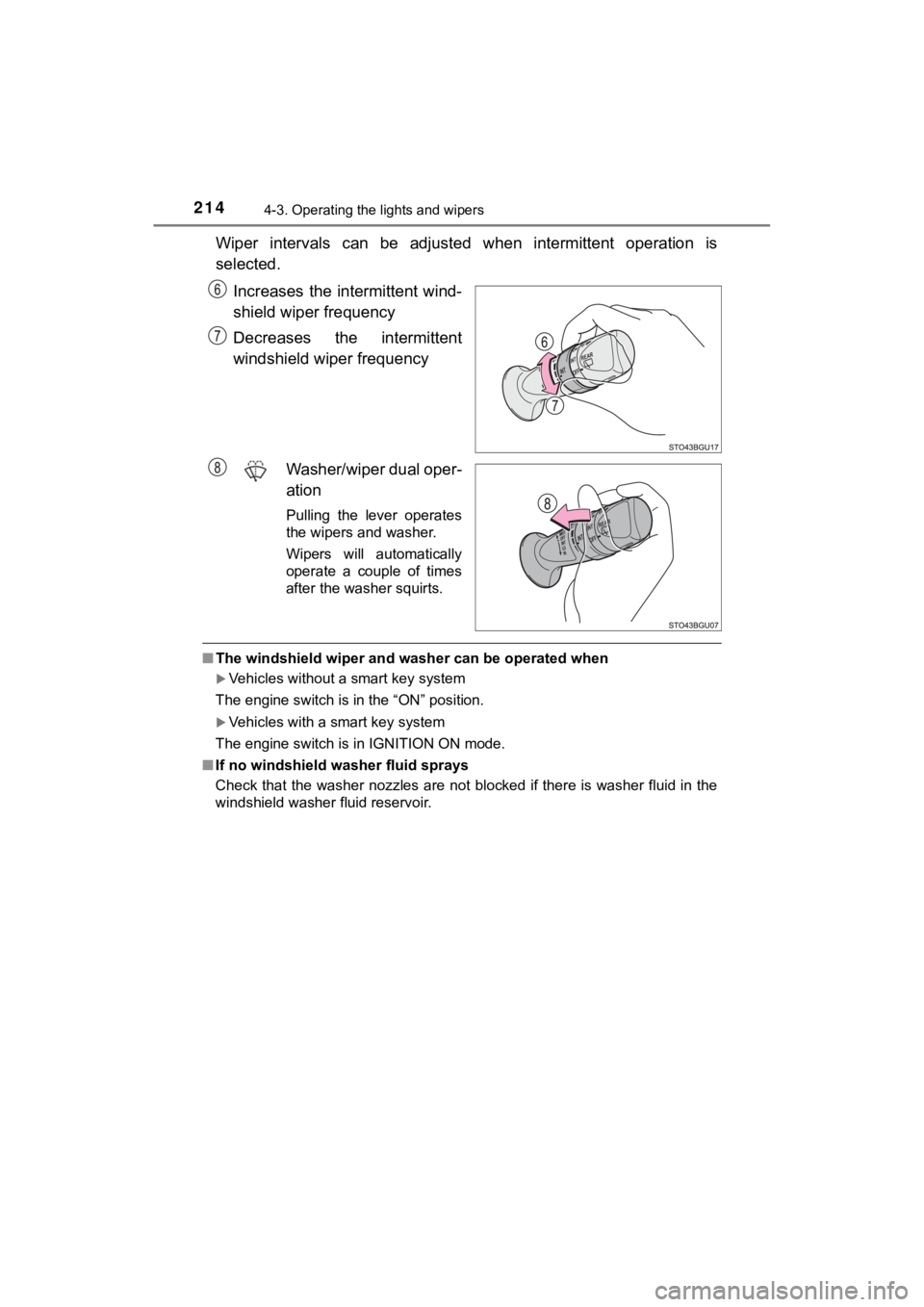
2144-3. Operating the lights and wipers
C-HR_OM_USA_OM10634U
Wiper intervals can be adjusted when intermittent operation is
selected.Increases the intermittent wind-
shield wiper frequency
Decreases the intermittent
windshield wiper frequency
Washer/wiper dual oper-
ation
Pulling the lever operates
the wipers and washer.
Wipers will automatically
operate a couple of times
after the washer squirts.
■The windshield wiper and washer can be operated when
Vehicles without a smart key system
The engine switch is in the “ON” position.
Vehicles with a smart key system
The engine switch is in IGNITION ON mode.
■ If no windshield washer fluid sprays
Check that the washer nozzles are not blocked if there is washe r fluid in the
windshield washer fluid reservoir.
6
Page 217 of 536
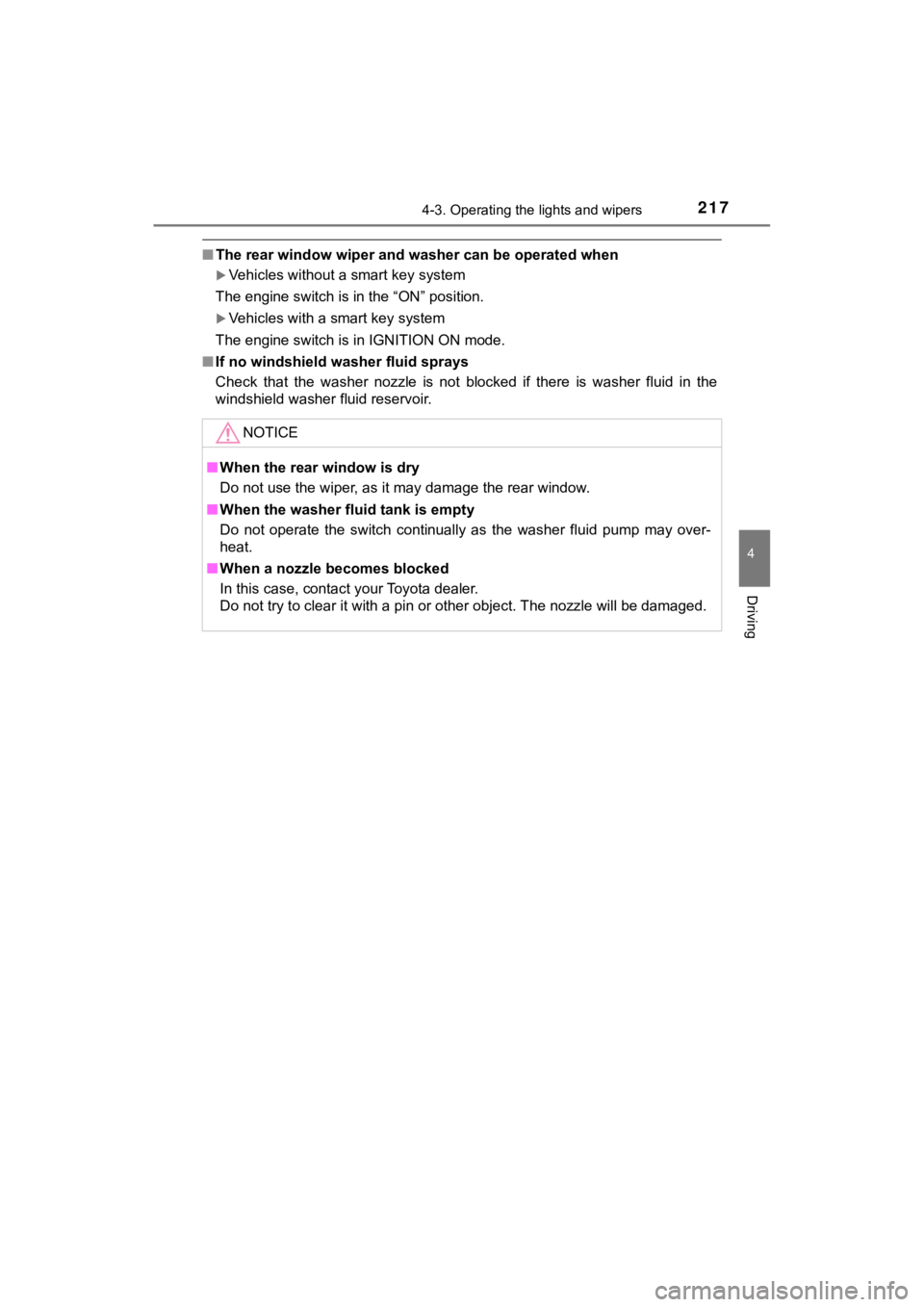
2174-3. Operating the lights and wipers
4
Driving
C-HR_OM_USA_OM10634U
■The rear window wiper and washer can be operated when
Vehicles without a smart key system
The engine switch is in the “ON” position.
Vehicles with a smart key system
The engine switch is in IGNITION ON mode.
■ If no windshield washer fluid sprays
Check that the washer nozzle is not blocked if there is washer fluid in the
windshield washer fluid reservoir.
NOTICE
■ When the rear window is dry
Do not use the wiper, as it may damage the rear window.
■ When the washer fluid tank is empty
Do not operate the switch continually as the washer fluid pump may over-
heat.
■ When a nozzle becomes blocked
In this case, contact your Toyota dealer.
Do not try to clear it with a pin or other object. The nozzle w ill be damaged.
Page 292 of 536
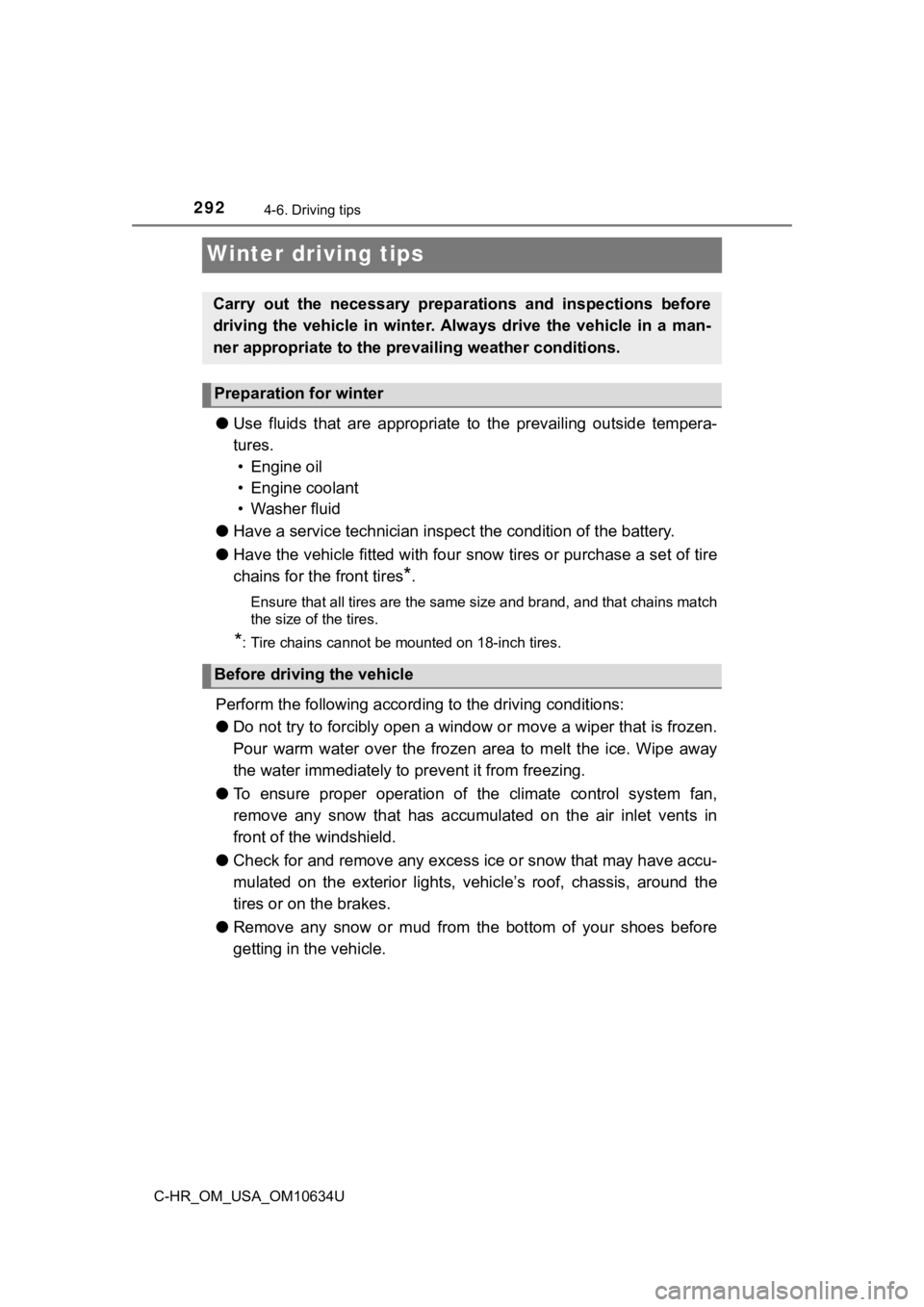
2924-6. Driving tips
C-HR_OM_USA_OM10634U
Winter driving tips
●Use fluids that are appropriate t o the prevailing outside tempera-
tures. • Engine oil
• Engine coolant
• Washer fluid
● Have a service technician inspec t the condition of the battery.
● Have the vehicle fitted with four snow tires or purchase a set of tire
chains for the front tires
*.
Ensure that all tires are the same size and brand, and that chains match
the size of the tires.
*: Tire chains cannot be mounted on 18-inch tires.
Perform the following according to the driving conditions:
● Do not try to forcibly open a window or move a wiper that is fr ozen.
Pour warm water over the frozen area to melt the ice. Wipe away
the water immediately to p revent it from freezing.
● To ensure proper operation of the climate control system fan,
remove any snow that has accumulated on the air inlet vents in
front of the windshield.
● Check for and remove any excess ic e or snow that may have accu-
mulated on the exterior lights, vehicle’s roof, chassis, around the
tires or on the brakes.
● Remove any snow or mud from the bottom of your shoes before
getting in the vehicle.
Carry out the necessary preparations and inspections before
driving the vehicle in winter. Always drive the vehicle in a ma n-
ner appropriate to the prevailing weather conditions.
Preparation for winter
Before driving the vehicle
Page 325 of 536
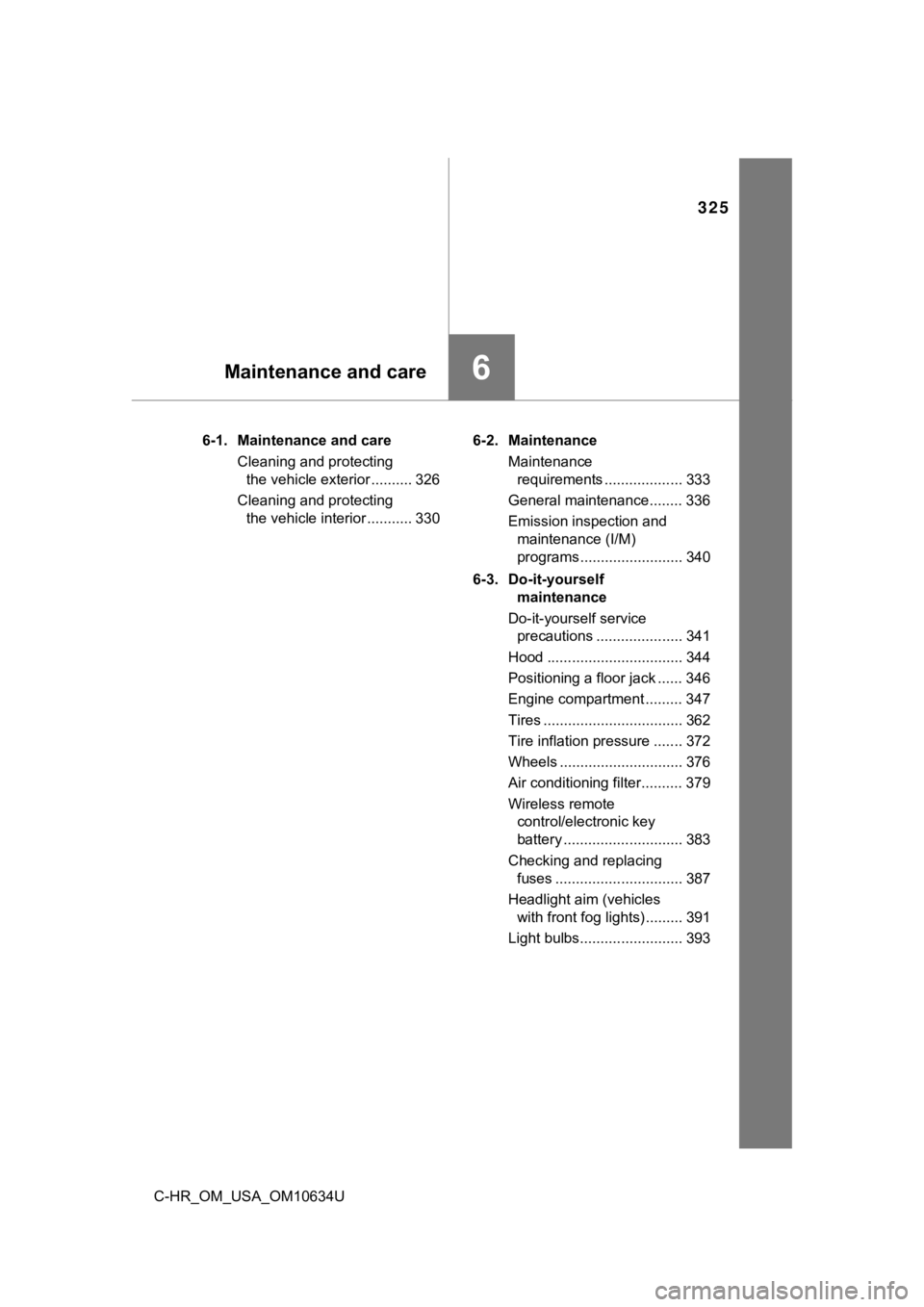
325
6Maintenance and care
C-HR_OM_USA_OM10634U6-1. Maintenance and care
Cleaning and protecting the vehicle exterior .......... 326
Cleaning and protecting the vehicle interior ........... 330 6-2. Maintenance
Maintenance requirements ................... 333
General maintenance........ 336
Emission inspection and maintenance (I/M)
programs......................... 340
6-3. Do-it-yourself maintenance
Do-it-yourself service precautions ..................... 341
Hood ................................. 344
Positioning a floor jack ...... 346
Engine compartment ......... 347
Tires .................................. 362
Tire inflation pressure ....... 372
Wheels .............................. 376
Air conditioning filter.......... 379
Wireless remote control/electronic key
battery ............................. 383
Checking and replacing fuses ............................... 387
Headlight aim (vehicles with front fog lights) ......... 391
Light bulbs......................... 393
Page 424 of 536
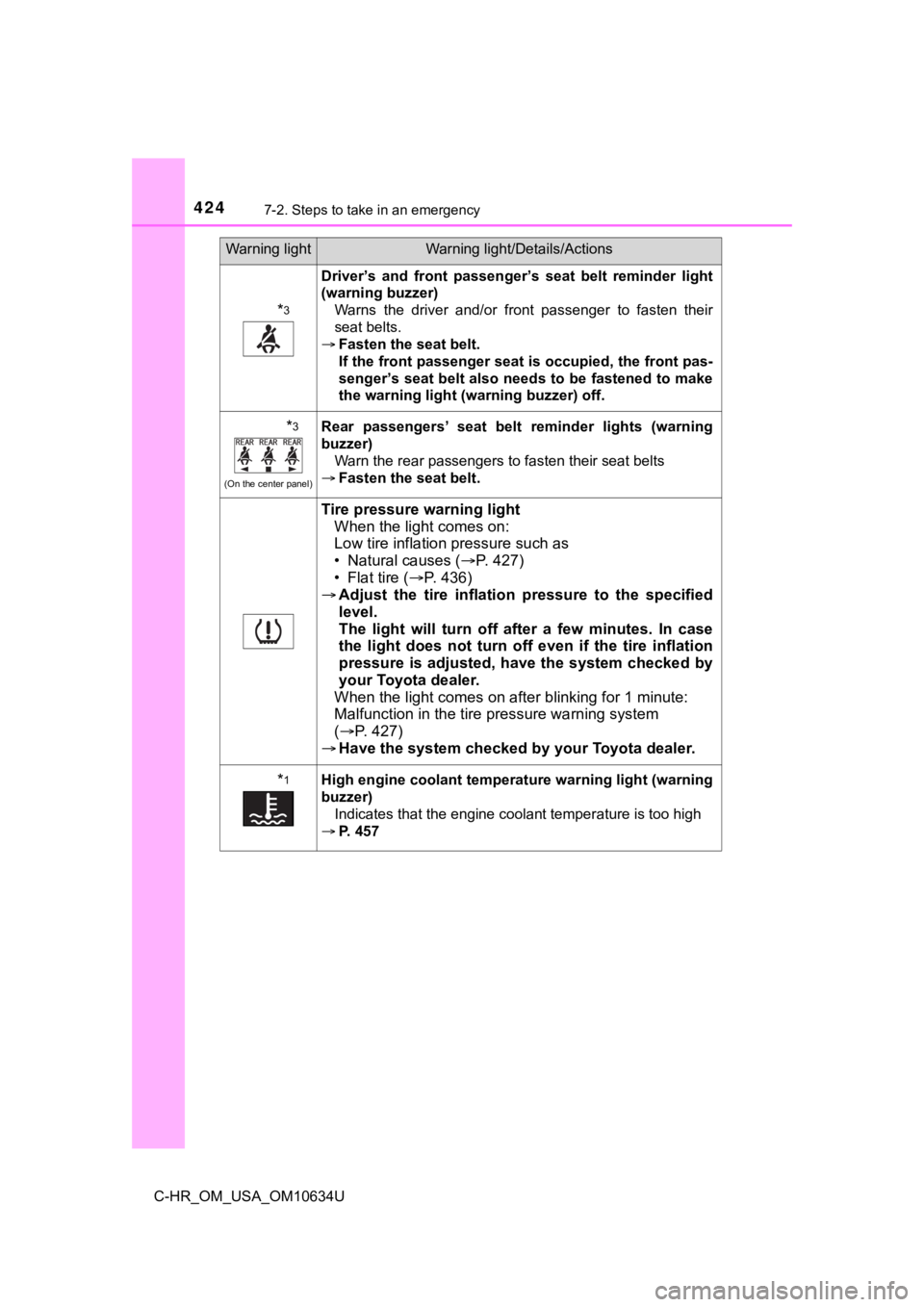
4247-2. Steps to take in an emergency
C-HR_OM_USA_OM10634U
*3
Driver’s and front passenger’s seat belt reminder light
(warning buzzer) Warns the driver and/or front passenger to fasten their
seat belts.
Fasten the seat belt.
If the front passenger seat is occupied, the front pas-
senger’s seat belt also needs to be fastened to make
the warning light (warning buzzer) off.
*3
(On the center panel)
Rear passengers’ seat belt reminder lights (warning
buzzer)
Warn the rear passengers to fasten their seat belts
Fasten the seat belt.
Tire pressure warning light
When the light comes on:
Low tire inflation pressure such as
• Natural causes ( P. 4 2 7 )
• Flat tire ( P. 436)
Adjust the tire inflation pressure to the specified
level.
The light will turn off after a few minutes. In case
the light does not turn off even if the tire inflation
pressure is adjusted, have the system checked by
your Toyota dealer.
When the light comes on after blinking for 1 minute:
Malfunction in t he tire pressure warning system
( P. 4 2 7 )
Have the system checked by your Toyota dealer.
*1High engine coolant temperature warning light (warning
buzzer)
Indicates that the engine coolant temperature is too high
P. 457
Warning lightWarning light/Details/Actions
Page 427 of 536
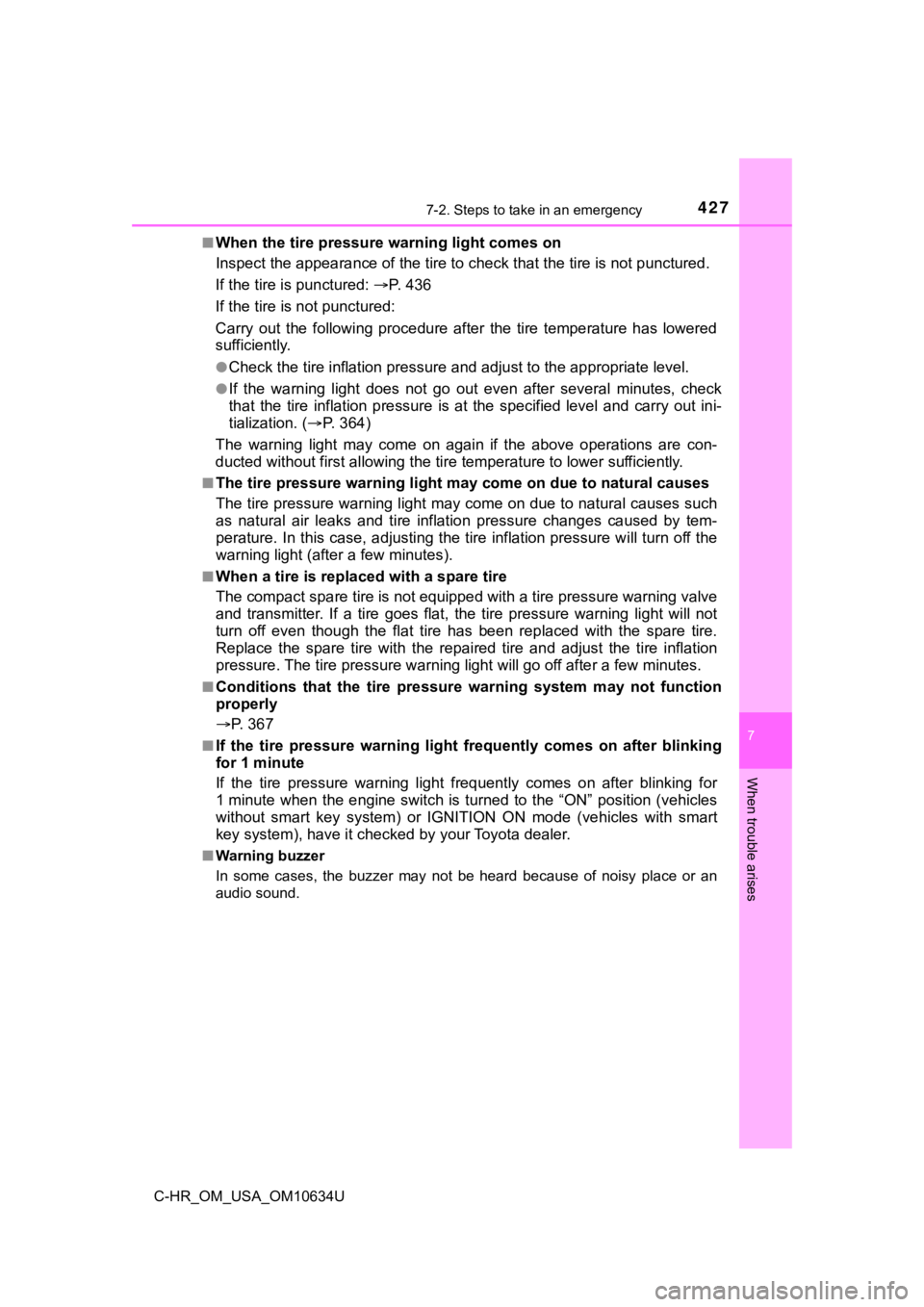
4277-2. Steps to take in an emergency
7
When trouble arises
C-HR_OM_USA_OM10634U■
When the tire pressure warning light comes on
Inspect the appearance of the ti
re to check that the tire is not punctured.
If the tire is punctured: P. 436
If the tire is not punctured:
Carry out the following procedure after the tire temperature has lowered
sufficiently.
●Check the tire inflation pressure and adjust to the appropriate level.
●If the warning light does not go out even after several minutes , check
that the tire inflation pressure is at the specified level and carry out ini-
tialization. ( P. 3 6 4 )
The warning light may come on again if the above operations are con-
ducted without first allowing t he tire temperature to lower suf ficiently.
■The tire pressure warning light may come on due to natural caus es
The tire pressure warning light may come on due to natural caus es such
as natural air leaks and tire inflation pressure changes caused by tem-
perature. In this case, adjusting the tire inflation pressure w ill turn off the
warning light (afte r a few minutes).
■When a tire is replace d with a spare tire
The compact spare tire is not equipped with a tire pressure war ning valve
and transmitter. If a tire goes flat, the tire pressure warning light will not
turn off even though the flat tire has been replaced with the s pare tire.
Replace the spare tire with the repaired tire and adjust the ti re inflation
pressure. The tire pressure war ning light will go off after a few minutes.
■Conditions that the tire pressure warning system may not functi on
properly
P. 3 6 7
■If the tire pressure warning light frequently comes on after bl inking
for 1 minute
If the tire pressure warning light frequently comes on after bl inking for
1 minute when the engine switch is turned to the “ON” position (vehicles
without smart key system) or IGNITION ON mode (vehicles with sm art
key system), have it checked by your Toyota dealer.
■Warning buzzer
In some cases, the buzzer may not be heard because of noisy pla ce or an
audio sound.
Page 454 of 536

4547-2. Steps to take in an emergency
C-HR_OM_USA_OM10634U
Vehicles without a smart key system:
Maintain the engine speed of the second vehicle and turn the
engine switch to the “ON” position, then start the vehicle’s engine.
Vehicles with a smart key system:
Maintain the engine speed of the second vehicle and turn the
engine switch to IGNITION ON m ode, then start the vehicle’s
engine.
Once the vehicle’s engine has st arted, remove the jumper cables in
the exact reverse order from which they were connected.
To install the engine cover, conduct the removal procedure in
reverse. After installing, check that the fixed pins are inserted
securely.
Once the engine starts, have the vehicle inspected at your Toyota
dealer as soon as possible.
■ Starting the engine when t he battery is discharged
The engine cannot be started by push-starting.
■ To prevent battery discharge
●Turn off the headlights and the air conditioning system while the engine is
stopped.
● Turn off any unnecessary electrical components when the vehicle is running
at a low speed for an extended period, such as in heavy traffic .
■ Charging the battery
The electricity stored in the battery will discharge gradually even when the
vehicle is not in use, due to natural discharge and the draining effects of cer-
tain electrical appliances. If the vehicle is left for a long t ime, the battery may
discharge, and the engine may be unable to start. (The battery recharges
automatically during driving.)
■ Precautions when the battery is discharged (vehicles with a sma rt key
system)
● In some cases, it may not be possible to unlock the doors using the smart
entry & start system when the battery is discharged. Use the wi reless
remote control or the mechanical key to lock or unlock the door s.
● The engine may not start on the first attempt after the battery has recharged
but will start normally after the second attempt. This is not a malfunction.
● The engine switch mode is memorized by the vehicle. When the ba ttery is
reconnected, the system will return to the mode it was in befor e the battery
was discharged. Before disconnecting the battery, turn the engine switch off.
If you are unsure what mode the engine switch was in before the battery dis-
charged, be especially careful when reconnecting the battery.
6
7
8
Page 455 of 536
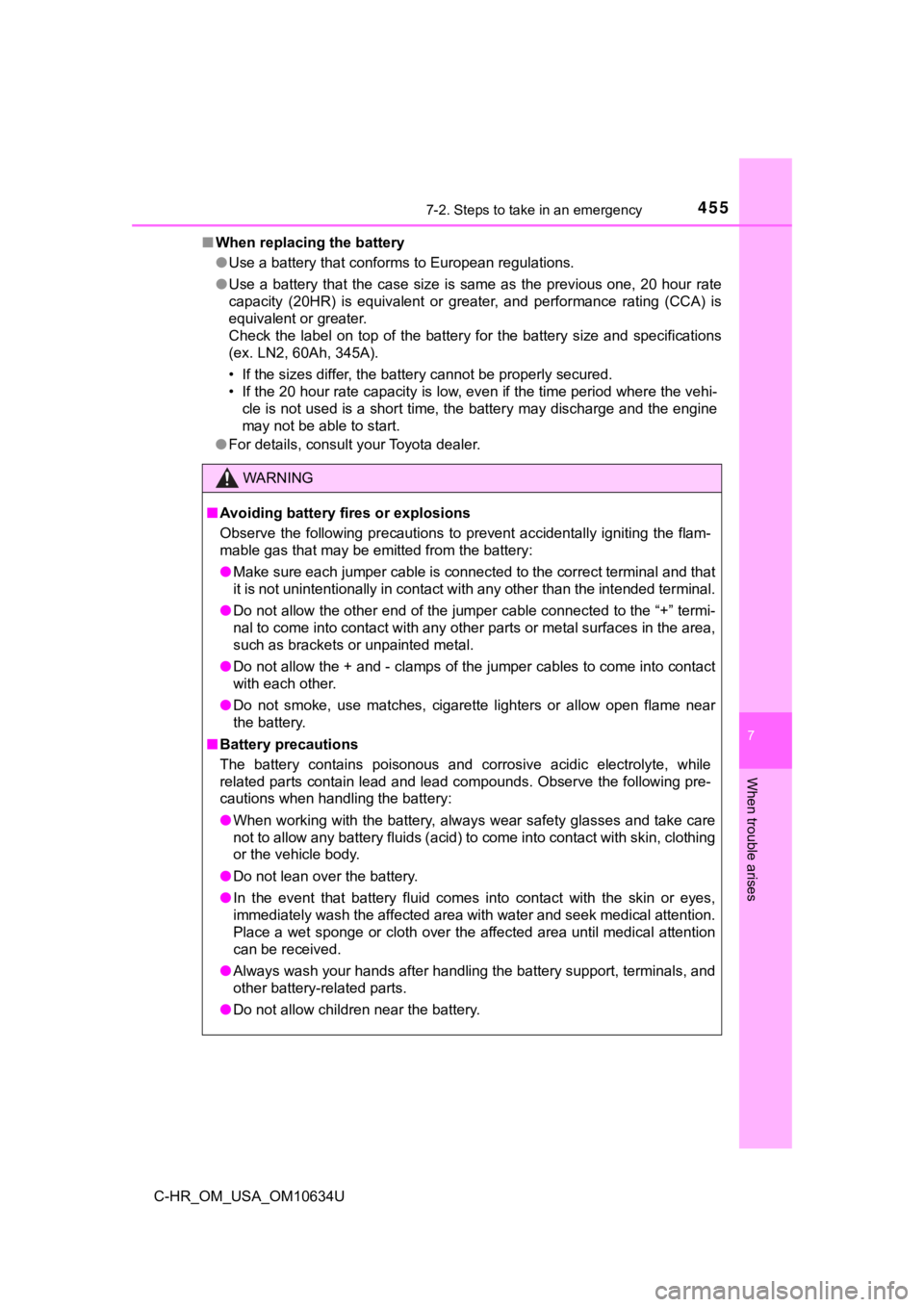
4557-2. Steps to take in an emergency
7
When trouble arises
C-HR_OM_USA_OM10634U■
When replacing the battery
●Use a battery that conforms to European regulations.
● Use a battery that the case size is same as the previous one, 20 hour rate
capacity (20HR) is equivalent or greater, and performance rating (CCA) is
equivalent or greater.
Check the label on top of the battery for the battery size and specifications
(ex. LN2, 60Ah, 345A).
• If the sizes differ, the battery cannot be properly secured.
• If the 20 hour rate capacity is low, even if the time period w here the vehi-
cle is not used is a short time, the battery may discharge and the engine
may not be able to start.
● For details, consult your Toyota dealer.
WARNING
■Avoiding battery fires or explosions
Observe the following precautions to prevent accidentally ignit ing the flam-
mable gas that may be emitted from the battery:
● Make sure each jumper cable is connected to the correct terminal and that
it is not unintentionally in contact with any other than the in tended terminal.
● Do not allow the other end of the jumper cable connected to the “+” termi-
nal to come into contact with any other parts or metal surfaces in the area,
such as brackets or unpainted metal.
● Do not allow the + and - clamps of the jumper cables to come in to contact
with each other.
● Do not smoke, use matches, cigarette lighters or allow open fla me near
the battery.
■ Battery precautions
The battery contains poisonous and corrosive acidic electrolyte , while
related parts contain lead and lead compounds. Observe the foll owing pre-
cautions when handling the battery:
● When working with the battery, always wear safety glasses and t ake care
not to allow any battery fluids (acid) to come into contact wit h skin, clothing
or the vehicle body.
● Do not lean over the battery.
● In the event that battery fluid comes into contact with the skin or eyes,
immediately wash the affected area with water and seek medical attention.
Place a wet sponge or cloth over the affected area until medica l attention
can be received.
● Always wash your hands after handling the battery support, term inals, and
other battery-related parts.
● Do not allow children near the battery.
Page 524 of 536
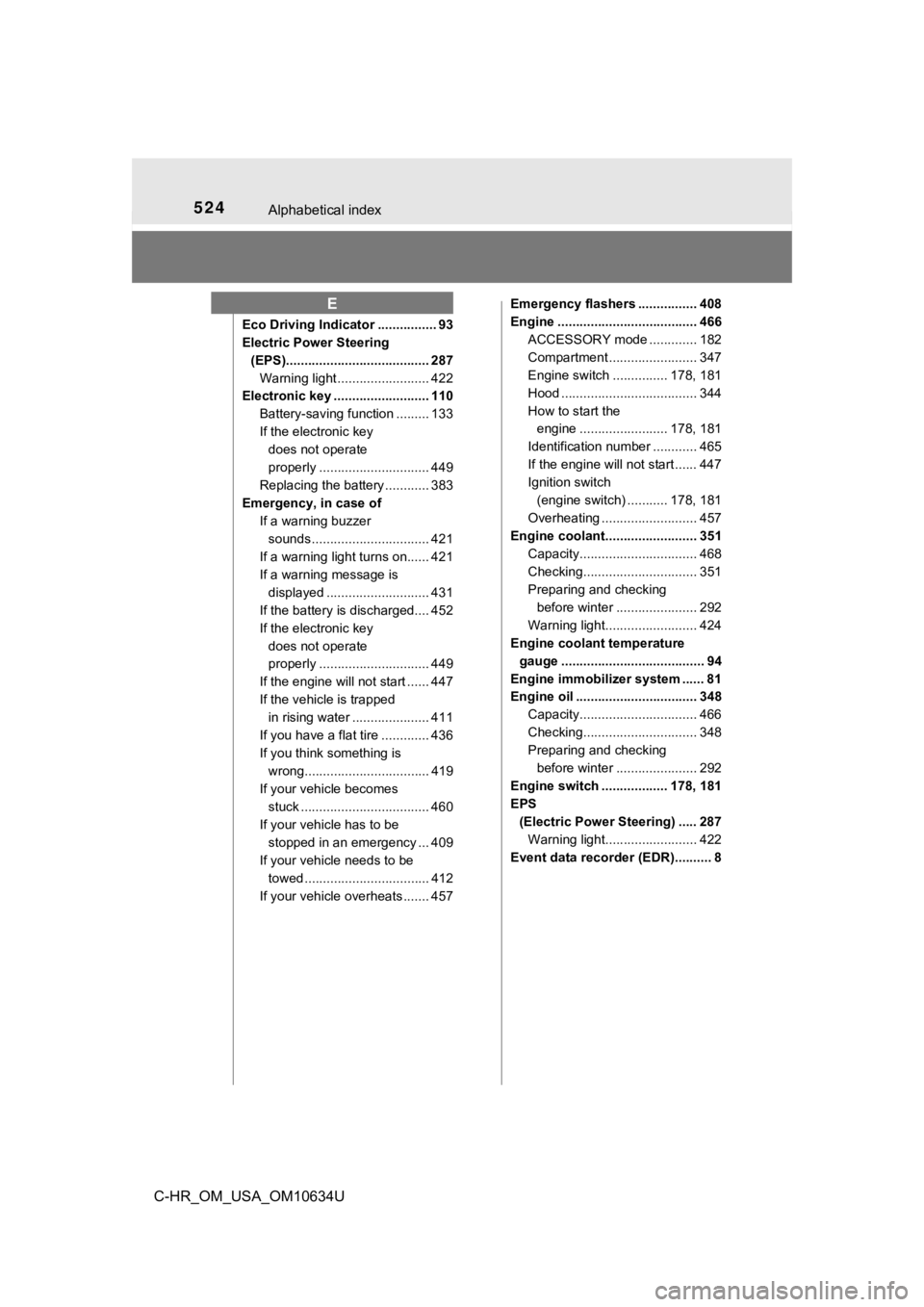
524Alphabetical index
C-HR_OM_USA_OM10634U
Eco Driving Indicator ................ 93
Electric Power Steering (EPS)....................................... 287 Warning light ......................... 422
Electronic key .......................... 110
Battery-saving function ......... 133
If the electronic key does not operate
properly .............................. 449
Replacing the battery ............ 383
Emergency, in case of
If a warning buzzer sounds ................................ 421
If a warning light turns on...... 421
If a warning message is
displayed ............................ 431
If the battery is discharged.... 452
If the electronic key
does not operate
properly .............................. 449
If the engine will not start ...... 447
If the vehicle is trapped in rising water ..................... 411
If you have a flat tire ............. 436
If you think something is wrong.................................. 419
If your vehicle becomes
stuck ................................... 460
If your vehicle has to be stopped in an emergency ... 409
If your vehicle needs to be towed .................................. 412
If your vehicle overheats ....... 457 Emergency flashers ................ 408
Engine ...................................... 466
ACCESSORY mode ............. 182
Compartment ........................ 347
Engine switch ............... 178, 181
Hood ..................................... 344
How to start the engine ........................ 178, 181
Identification number ............ 465
If the engine will not start ...... 447
Ignition switch (engine switch) ........... 178, 181
Overheating .......................... 457
Engine coolant......................... 351
Capacity................................ 468
Checking............................... 351
Preparing and checking before winter ...................... 292
Warning light......................... 424
Engine coolant temperature
gauge ....................................... 94
Engine immobilizer system ...... 81
Engine oil ................................. 348 Capacity................................ 466
Checking............................... 348
Preparing and checking before winter ...................... 292
Engine switch .................. 178, 181
EPS (Electric Power Steering) ..... 287
Warning light......................... 422
Event data recorder (EDR).......... 8
E